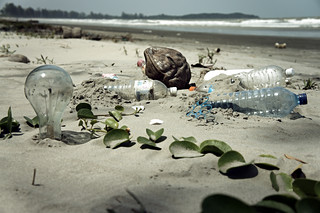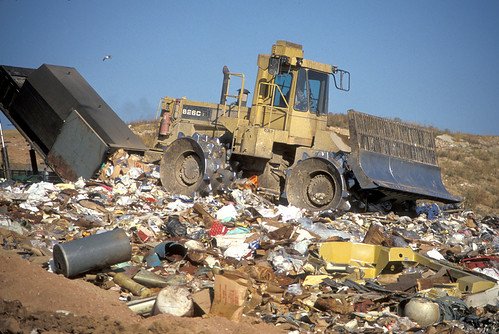Wasting Away (by Lee Epstein)

Posted November 26, 2013 at 1:25PM
As we enter America’s traditional, annual season of excess, my collaborator Lee Epstein reminds us why overconsumption and waste have consequences. Lee is an attorney and land use planner working for sustainability in the mid-Atlantic region.
There’s a place not too far from here – and not too far from where you are reading this right now, either – where all the stuff we don’t want ends up.
It’s the final resting place for the trash we throw out, a place where all the physical detritus associated with our living on earth eventually settles. This includes not only grungy old mattresses but minute particles of air pollution; not only millions of tons of rotten food, but the polluted water we try to shunt quickly off our farms and parking lots and streets. It includes the carbon and methane, nitrogen oxide and other compounds that pour from fossil fuel combustion, industry, farms and mining processes, and the construction waste created when we build new buildings or get rid of old ones. This place is not on a map, but it does have a name. It’s called Away. It’s huge.
We throw things away. Pollution goes away. Water flows away. And if we’re staying in one place, after this material goes away and for some very brief period of time, that one place is “clean” again – whether it’s a city street, the air we breathe, or the trash can. So how do we perform this cosmic magic trick that defies one of the laws of physics (the Law of Conservation of Matter)? Well, we all know there’s no such thing as magic, right? It’s all just sleight of hand; that’s why it’s called a “trick,” after all.
It’s actually pretty easy, like most tricks once you know them and practice a bit. We distract ourselves for a moment with, you know, life, and that’s when the stuff goes away, and we really don’t care about where as long as it’s not too close-by. So we try to bury our trash in engineered mountains after a bit of recycling of the most valuable materials, and some of it decomposes or falls apart, or just sinks farther into the ground to deteriorate ever so slowly.  Or we send those noxious air pollution particles skyward to be breathed in or carried aloft until the rain brings them back down again, somewhere else. And the toxins in polluted water runoff get sluiced into nearby streams, and then rivers, and some make it to estuaries and even the ocean, sometimes nearby or sometimes far from the source – to be drunk, or washed with, or played or fished in.
Or we send those noxious air pollution particles skyward to be breathed in or carried aloft until the rain brings them back down again, somewhere else. And the toxins in polluted water runoff get sluiced into nearby streams, and then rivers, and some make it to estuaries and even the ocean, sometimes nearby or sometimes far from the source – to be drunk, or washed with, or played or fished in.
So our communities are nice and fresh again. ¡Que milagro! (What a miracle!)
But isn’t Away getting kind of full? Well, honestly, it is: With the 35 billion tons per year of carbon dioxide we humans spill into the atmosphere; the 230 million tons per year of nitrogen gases; the two billion tons per year of other air pollution; the 730 million tons per year of pollution we discharge into the water (that’s more than the weight of all of Earth’s human population); the 1.3 billion tons per year of food waste; and the 1.3 billion tons per year of solid waste or trash. The problem is, Earth has been called a “spaceship” for a reason: it’s a single, rather small planet hurtling through space. And everything’s rather contained on the ground, in the water, or in the air – so really, of course, there’s no Away.
This reminds me of a story. One of my first professional jobs was helping local governments around the country deal with solid and hazardous waste. I recall putting together a solid waste management workshop for some local officials in the desert southwest. At its conclusion, one grizzled “garbage” professional from a small town came up to me and said, “Son, we don’t really have a solid waste problem down here. We just put it all in an arroyo, and when the rains come a couple times a year, it all gets washed away. Problem solved,” he said with a click of his fingers and a wink.
Everything we do, everything we use and discard, every action we take that results in waste being generated – whether throwing away some food from our refrigerator, driving to the grocery store, building a building, manufacturing parts for an airplane, turning on an electric light, buying some new consumer electronic gadget, or even building new development where it really doesn’t belong – results in something going to that mythical place.
 A recent report from the Container Recycling Institute (CRI) (Bottled Up 2000-2010) provides some depressing statistics on the current habits of the U.S.’s throw-away culture: of 243 billion beverage containers sold in the United States in 2010, 153 billion were either sent to landfills, littered or incinerated. Our national “wasting rate” is 63 percent for 2010, a 7 percent increase over 2000’s wasting rate of 59 percent, which itself increased by 20 percent over that in 1990. The trend is going in the wrong direction. Indeed, according to Susan Collins, the president of CRI (reported by Julia Pyper in an October 31 story in ClimateWire), “if the 153 billion containers wasted in 2010 had been recycled instead, it could have saved enough energy to power nearly all of the homes in Los Angeles and Chicago combined. This level of recycling could have prevented the release of 11.6 million tons of greenhouse gas emissions, or the equivalent of taking 2.3 million cars off the road.”
A recent report from the Container Recycling Institute (CRI) (Bottled Up 2000-2010) provides some depressing statistics on the current habits of the U.S.’s throw-away culture: of 243 billion beverage containers sold in the United States in 2010, 153 billion were either sent to landfills, littered or incinerated. Our national “wasting rate” is 63 percent for 2010, a 7 percent increase over 2000’s wasting rate of 59 percent, which itself increased by 20 percent over that in 1990. The trend is going in the wrong direction. Indeed, according to Susan Collins, the president of CRI (reported by Julia Pyper in an October 31 story in ClimateWire), “if the 153 billion containers wasted in 2010 had been recycled instead, it could have saved enough energy to power nearly all of the homes in Los Angeles and Chicago combined. This level of recycling could have prevented the release of 11.6 million tons of greenhouse gas emissions, or the equivalent of taking 2.3 million cars off the road.”
Air pollution. Water pollution. Solid waste. Toxic chemicals. Energy use and climate change. We know that there is no Away. Award-winning architect/designer William McDonough, together with German chemist Michael Braungart in their groundbreaking 2002 book Cradle to Cradle: Remaking the Way We Make Things, posited that ultimately, sustainability means designing and building things without any waste, which make all the energy they need or create more energy than they use, and which can, when their useful life is over, be readily deconstructed without waste and fully used again. Their principles apply to homes and office buildings, as well as to computer servers and cell phones. Such thinking, and surely such doing, is still very much a work in progress. But it must proceed.
Because Away is just another name for planet Earth. And right now, it’s the only home we’ve got.
Recent posts by Lee Epstein:
- Augusta's new master plan for revitalization looks like a winner (by Lee Epstein) (October 16, 2013)
- Whither intelligent vehicles and automated highways? (with Lee Epstein) (June 17, 2013)
- Is there a way to (downtown) San Jose? (by Lee Epstein) (May 6, 2013)
- The essential elements of green cities (by Lee Epstein) (April 3, 2013)
- Meet the nation's biggest landlord (and developer) (with Lee Epstein) (February 6, 2013)
Move your cursor over the images for credit information.
.
